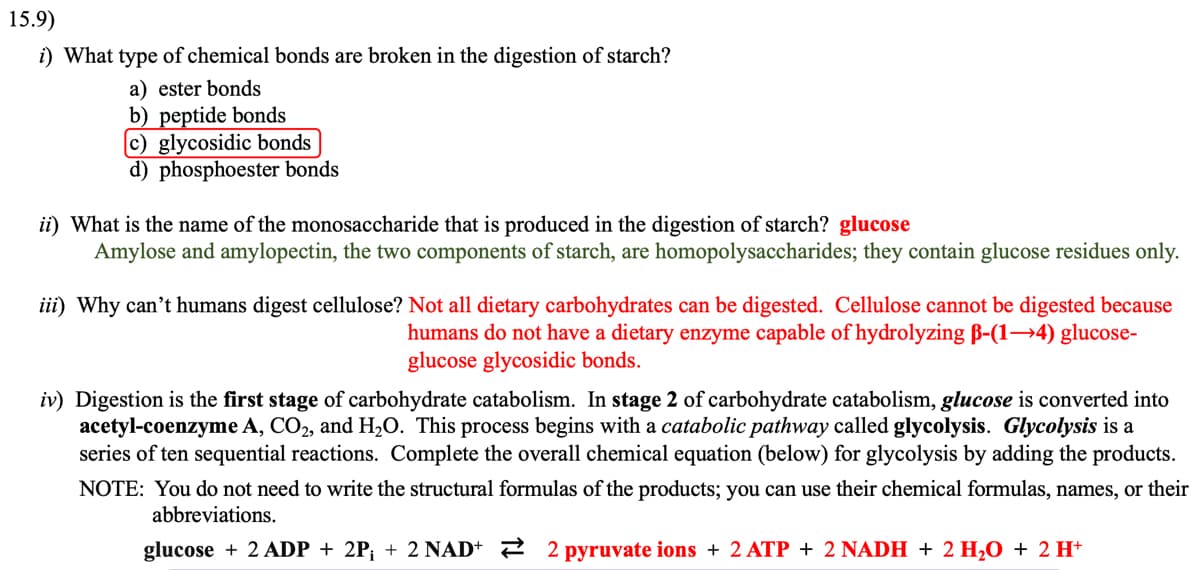15.9) i) What type of chemical bonds are broken in the digestion of starch? a) ester bonds b) peptide bonds c) glycosidic bonds d) phosphoester bonds ii) What is the name of the monosaccharide that is produced in the digestion of starch? glucose Amylose and amylopectin, the two components of starch, are homopolysaccharides; they contain glucose residues only. iii) Why can't humans digest cellulose? Not all dietary carbohydrates can be digested. Cellulose cannot be digested because humans do not have a dietary enzyme capable of hydrolyzing B-(1-4) glucose- glucose glycosidic bonds. iv) Digestion is the first stage of carbohydrate catabolism. In stage 2 of carbohydrate catabolism, glucose is converted into acetyl-coenzyme A, CO2, and H₂O. This process begins with a catabolic pathway called glycolysis. Glycolysis is a series of ten sequential reactions. Complete the overall chemical equation (below) for glycolysis by adding the products. NOTE: You do not need to write the structural formulas of the products; you can use their chemical formulas, names, or their abbreviations. glucose + 2 ADP + 2P₁ + 2 NAD+ 2 pyruvate ions + 2 ATP + 2 NADH + 2 H₂O + 2 H+
15.9) i) What type of chemical bonds are broken in the digestion of starch? a) ester bonds b) peptide bonds c) glycosidic bonds d) phosphoester bonds ii) What is the name of the monosaccharide that is produced in the digestion of starch? glucose Amylose and amylopectin, the two components of starch, are homopolysaccharides; they contain glucose residues only. iii) Why can't humans digest cellulose? Not all dietary carbohydrates can be digested. Cellulose cannot be digested because humans do not have a dietary enzyme capable of hydrolyzing B-(1-4) glucose- glucose glycosidic bonds. iv) Digestion is the first stage of carbohydrate catabolism. In stage 2 of carbohydrate catabolism, glucose is converted into acetyl-coenzyme A, CO2, and H₂O. This process begins with a catabolic pathway called glycolysis. Glycolysis is a series of ten sequential reactions. Complete the overall chemical equation (below) for glycolysis by adding the products. NOTE: You do not need to write the structural formulas of the products; you can use their chemical formulas, names, or their abbreviations. glucose + 2 ADP + 2P₁ + 2 NAD+ 2 pyruvate ions + 2 ATP + 2 NADH + 2 H₂O + 2 H+
Biochemistry
9th Edition
ISBN:9781319114671
Author:Lubert Stryer, Jeremy M. Berg, John L. Tymoczko, Gregory J. Gatto Jr.
Publisher:Lubert Stryer, Jeremy M. Berg, John L. Tymoczko, Gregory J. Gatto Jr.
Chapter1: Biochemistry: An Evolving Science
Section: Chapter Questions
Problem 1P
Related questions
Question
100%
I don't understand it. Can u help me? Can u help me to explain this to me Number 9 part 2, part 3, part 4?

Transcribed Image Text:15.9)
i) What type of chemical bonds are broken in the digestion of starch?
a) ester bonds
b) peptide bonds
(c) glycosidic bonds
d) phosphoester bonds
ii) What is the name of the monosaccharide that is produced in the digestion of starch? glucose
Amylose and amylopectin, the two components of starch, are homopolysaccharides; they contain glucose residues only.
iii) Why can't humans digest cellulose? Not all dietary carbohydrates can be digested. Cellulose cannot be digested because
humans do not have a dietary enzyme capable of hydrolyzing ß-(1-4) glucose-
glucose glycosidic bonds.
iv) Digestion is the first stage of carbohydrate catabolism. In stage 2 of carbohydrate catabolism, glucose is converted into
acetyl-coenzyme A, CO2, and H₂O. This process begins with a catabolic pathway called glycolysis. Glycolysis is a
series of ten sequential reactions. Complete the overall chemical equation (below) for glycolysis by adding the products.
NOTE: You do not need to write the structural formulas of the products; you can use their chemical formulas, names, or their
abbreviations.
glucose + 2 ADP + 2P; + 2 NAD+ 2 pyruvate ions + 2 ATP + 2 NADH + 2 H₂O + 2 H+
Expert Solution
This question has been solved!
Explore an expertly crafted, step-by-step solution for a thorough understanding of key concepts.
Step by step
Solved in 4 steps

Recommended textbooks for you

Biochemistry
Biochemistry
ISBN:
9781319114671
Author:
Lubert Stryer, Jeremy M. Berg, John L. Tymoczko, Gregory J. Gatto Jr.
Publisher:
W. H. Freeman

Lehninger Principles of Biochemistry
Biochemistry
ISBN:
9781464126116
Author:
David L. Nelson, Michael M. Cox
Publisher:
W. H. Freeman

Fundamentals of Biochemistry: Life at the Molecul…
Biochemistry
ISBN:
9781118918401
Author:
Donald Voet, Judith G. Voet, Charlotte W. Pratt
Publisher:
WILEY

Biochemistry
Biochemistry
ISBN:
9781319114671
Author:
Lubert Stryer, Jeremy M. Berg, John L. Tymoczko, Gregory J. Gatto Jr.
Publisher:
W. H. Freeman

Lehninger Principles of Biochemistry
Biochemistry
ISBN:
9781464126116
Author:
David L. Nelson, Michael M. Cox
Publisher:
W. H. Freeman

Fundamentals of Biochemistry: Life at the Molecul…
Biochemistry
ISBN:
9781118918401
Author:
Donald Voet, Judith G. Voet, Charlotte W. Pratt
Publisher:
WILEY

Biochemistry
Biochemistry
ISBN:
9781305961135
Author:
Mary K. Campbell, Shawn O. Farrell, Owen M. McDougal
Publisher:
Cengage Learning

Biochemistry
Biochemistry
ISBN:
9781305577206
Author:
Reginald H. Garrett, Charles M. Grisham
Publisher:
Cengage Learning

Fundamentals of General, Organic, and Biological …
Biochemistry
ISBN:
9780134015187
Author:
John E. McMurry, David S. Ballantine, Carl A. Hoeger, Virginia E. Peterson
Publisher:
PEARSON